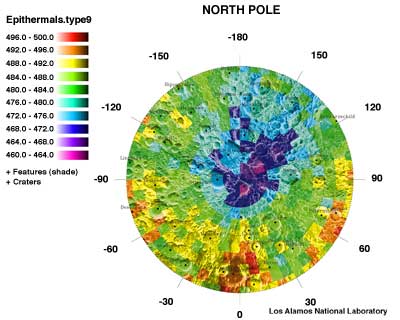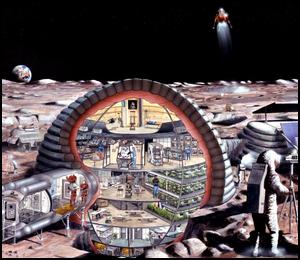|
Mainland High School
Cutting the Cord: ISTF 07-1726 |
||
|
Home
Introduction Components One Two  Product Product
Three Microwave Research W. C. Brown Generators History Phased Arrays Properties Rectennas Semiconductors Solar Satellites Superconductors Moon Research Colonization Helium-3 Fusion Geography Mining Resources Project Assessment Bibliography Glossary Team |
Moon Colonization
There is nearly no new, unclaimed territory on the Earth. The Arctic is one place that many countries are still trying to claim. It has recently become a bit more accessible, and there are benefits to owning part of the Arctic; such as the very profitable oil under the melting glaciers. Everyone wants a piece, and everyone is trying to plant their flags and claim the land in some way. No countries can agree on who should own what because they all want more than everyone else. This is the same way countries will feel when the moon becomes more accessible.
International law (especially the Outer Space Treaty of 1967) states that no country can own any celestial body, including the moon. This means as of right now no one entity can claim any part of the moon. If the use of any part of the moon is approved by all countries, however, to be for the common good, like for scientific or exploratory purposes, then it can be used. The only thing it cannot be used for is military purposes, and any use can be inspected by any country. The Moon Treaty of 1979, which is only supported by a handful of non-spacefaring nations, elaborates on many things in the Outer Space Treaty. One thing it clarifies is the possibility for exploitation of the moon's natural resources. It says that any samples can be taken for scientific purposes, but it also states the possibility of mining the moon. This mining would be regulated by an international regime which would make sure the resources would be used safely and efficiently. The benefit from these resources would also be controlled by this regime with special consideration paid to countries that need it especially, and the ones who contributed to the effort. If the moon becomes more accessible it may turn the way the Arctic did. Countries may want to actually own part of the moon and not just be permitted to use part of it, and the laws may change. It may become that accessible very soon with all the plans a handful of countries have for it. China has plans for the moon, but they are mostly just for sending probes for sample collections. They do plan for manned missions, and though not much has been released about when, manned missions are not planned for before 2020. They do not seem to be concerned with manned missions as much as the U.S. and Russia. Russia has plans for manned missions to the moon by 2025. The U.S. has much more urgent plans. They want to put people back on the moon by 2015. They even have plans for a permanent base somewhat like the bases in Antarctica by 2020. There are several opportunities for space construction on the moon. The most basic of which is to just do everything really slow and carefully, 16.6% as slow at least. That's because the gravity on the moon is 16.6% of that on earth. There are more innovative solutions though. The most economical solution would be for the entire facility to be built underground. Being underground it would be shielded from the constant bombardment of space debris, have a more solid foundation, and would prepare the first few shipments of moon rock to be sent to earth while just constructing the facility. That leaves us with the following predicament: we need a base on the moon of which to work from, or we need to move a few tons of moon compatible construction equipment. That is possible and already being researched by NASA. The only concern would be the digging machines not making sufficient progress because the moon has 16.6% Earth's gravity. The Moon is a receptor for potentially deadly radiation. Currently NASA is working on electrically charged shield spheres to see if they are going to be powerful enough to protect a potentially heavily populated moon base. This is actually one of the more simplistic ideas that researchers are pursuing for moon bases. Some of the more complex ideas that are under research include, the multi shield approach in which the shields are placed low to the ground to prevent moon dust from clogging up generators. According to NASA the surface of the moon is a very good candidate to receive deadly radiation. Those radiations include cosmic rays and solar flares as well as the fact that the cosmic rays hit the ground which produces a secondary radiation right at your feet. There are some estimates to the levels of radiation on the moon but most researchers suspect it is close to, if not a little more than, the planet Mars which the estimate for cosmic galactic rays tends to be from .3Sv per year to about 1Sv per year. The colonization of humans on the moon would be possible with certain criteria for humans to work and function. The first key point of placing humans on the moon is the location. The best place on the moon is the south region of the moon facing towards the Earth. Astronauts would have needed benefits in the southern region of the moon: 340 days of sunlight per year, source of solar electric power, and possible hydrogen source for used for powering equipment. A specified location on the moon for a lunar base for humans to live is the Aristarchus Plateau, which is a bright place on the Moon. There is another location on the north polar region on the moon that has a supplied ice water possibly and well exposure of sunlight on the Peary Crater. The lunar base must be able to protect the humans from radiation and lack of atmosphere. There is an abundant supply of pyroclastic material around the plateau that can cover the lunar base, or by protecting the base underground by a lava tube. Resources are available on the moon with the deposit of pyroclastic. The pyroclastic grains have a great surface area which can capture the solar winds from the sun that carry gases. If the pyroclastic is heated to a certain temperature, it can capture the gases from the winds to get hydrogen and some helium. The hydrogen can be used with oxygen to make water vapor for the inhabitants. The captured hydrogen and oxygen can also be used to power electric in a fuel cell for dark days when the sun is not present over the moon. ASCE - Civil Engineering Database (subject keyword: "space construction") http://cedb.asce.org/ Associated Content - Will China Beat the United States Back to the Moon? http://www.associatedcontent.com/article/384514/will_china_beat_the_united_states_back.html Book Rags - Colonization of the Moon http://www.bookrags.com/Colonization_of_the_Moon Earth & Sky - Why go back to the moon? http://www.earthsky.org/radioshows/51145/why-go-back-to-the-moon Health Physics Society - What are the radiation levels on the moon and Mars? http://hps.org/publicinformation/ate/q1549.html MoonConnection.com - Moon's Gravity http://www.moonconnection.com/moon_gravity.phtml Moon Daily - Russia plans manned Moon mission by 2025 http://www.moondaily.com/reports/Russia_plans_manned_Moon_mission_by_2025_999.html NASA - Human Space Flight http://spaceflight.nasa.gov/gallery/images/mars/lunarbases/html/s89_20084.html NASA - Science, Research, and Technology News http://www.nasa.gov/audience/forresearchers/features/index.html NASA Lunar Prospector - Neutron Spectrometer Results http://lunar.arc.nasa.gov/results/neures.htm NewScientist - China plans three-phase Moon exploration http://www.newscientist.com/article/dn3452.html New York Times - NASA Plans Permanent Moon Base http://www.nytimes.com/2006/12/05/science/space/05nasa.html?_r=3&oref=slogin&oref=slogin&oref=slogin PSRD - Composition of the Moon's Crust http://www.psrd.hawaii.edu/Dec04/LunarCrust.html SPACE.com - Back to the Moon: Uniting Science and Exploration http://www.space.com/scienceastronomy/060516_science_tuesday.html SPACE.com - China Unveils Ambitious Space Plans at National Space Symposium http://www.space.com/news/060405_nss_china.html SPACE.com - Lunar Shields: Radiation Protection for Moon-Based Astronauts http://www.space.com/businesstechnology/lunarshield_techwed_050112.html SPACE.com - Perfect Spot Found for Moon Base http://www.space.com/scienceastronomy/050413_moon_perfect.html United Nations - Treaties and Principles on Outer Space http://www.unoosa.org/pdf/publications/STSPACE11E.pdf (pg 7) Universe Today - Radiation on the Moon http://www.universetoday.com/2005/09/09/radiation-on-the-moon/ U.S. Department of State - Outer Space Treaty http://www.state.gov/t/ac/trt/5181.htm WIRED - Today, Countries Battle for a Piece of the Arctic. Tomorrow? The Moon http://www.wired.com/science/space/magazine/15-12/st_essay |

